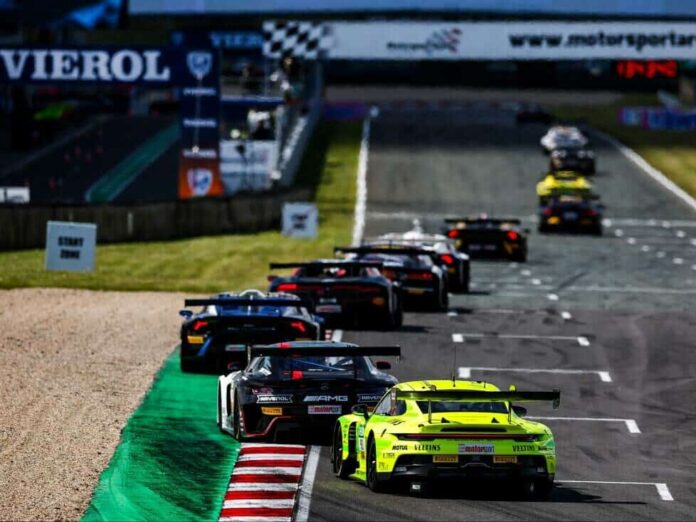In the DTM season opener at Oschersleben, FCY phases in both races made for a game of chance: Which teams’ approaches to a solution and who would change nothing
The DTM rule introduced this year, according to which compulsory stops are no longer possible during Full Course Yellow (FCY), caused a stir at the season opener in Oschersleben – and critical voices! On Saturday, Marco Wittmann almost won from 17th on the grid because he just managed to get into the pit lane when the speed limit on the track was already 80. And on Sunday, Luca Engstler and Maro Engel benefited
In future, how can we prevent drivers who are in the pit lane entrance area at the right time from being flushed to the front from far back and then having a big lead over the rest of the field? “I would reintroduce the slow zones.”
“This has already worked in Class 1, so nobody can tell me that it’s not technically possible,” says Fritz, who has already been in contact with the ADAC and the German Motor Sports Association (DMSB) about this. “It also works on the Nordschleife in the Code 60 area. “
“Then you have reduced the risk by 85 percent “
The concept of slow zones, which was already used in the DTM from 2015 to 2018, divides the track into segments, which means that the speed limit does not apply to the entire track, but only in the affected section. Thierry Vermeulen’s burning Ferrari on Sunday would therefore probably not have had any effect on the race, as the dangerous situation was not at the start-finish line and therefore not at the level of the pit lane.
The situation was different on Saturday, when Ben Dörr’s McLaren lost a wheel in the finishing bend, which rolled onto the track. “You are not immune to every situation, but if you divide the track into six slow zones, you have reduced the risk by 85 percent,” calculates Fritz.
And sees a number of advantages. “1) It’s much fairer at the pit stop. 2) It’s less likely that an incident will happen on the start-finish straight. 3) The spectators still enjoy racing on 85 percent of the track. 4) You don’t have the problem of the tires cooling down,” says the HRT team boss, who was in charge of the Mercedes entry in the Class 1 era of the DTM.
Fritz convinced: “There is no substantive argument against it “
Fritz also does not see the problem that a driver would be at a disadvantage if he arrives after his rivals at a point where the slow zone has just been declared: “Even in Class 1 times, we made sure that everyone drove through the slow zone exactly the same number of times. Then it’s totally fair.” It is therefore clear to him: “There is no substantive argument against it, at most there could be a technical problem.”
In fact, the complex implementation should not be underestimated: The GPS positions must be exact and the data transmission to the cars must also be absolutely reliable. In Class 1 times, the DTM was a manufacturer series with silhouette prototypes that had standardized electronics, which made things easier. In addition, the series was co-financed by the manufacturers, which meant that the expense was not a problem.
Tomczyk would close pit lane earlier
Abt Sports Director Martin Tomczyk sees another point that could be addressed: the ten-second countdown that announces FCY and also the closing of the pit lane, which takes place at the same time. This is because the countdown gives the drivers ten seconds to save themselves in the pit lane before it closes – and collect the jackpot.
“It would be best if the pit lights were red immediately,” says Tomczyk. “But that brings with it the risk that the pit lane is already closed when I as a driver speculate on a full-course yellow and drive into the pit lane entrance.” As a result, the stop would not count – and the driver’s race would be ruined.
Theoretically, it could even lead to dangerous situations where a driver drives back onto the track from the pit lane at the last moment and causes a stir. Therefore, the Abt sports director suggests as a compromise “that the pit lane entrance is closed from second 5 or so, because then I as the driver have at least a few seconds left. And that would make it easier for the race director to find this window.”
This is because race director Sven Stoppe always strives for fair conditions and usually waits for a window for FCY so that no driver has an advantage. “I’m sure that Sven and the DMSB will have their thoughts,” says Tomczyk, expecting a reaction from those responsible to the FCY issue. “Sven is also under pressure, because FCY is first and foremost a safety issue. You can’t take sensitivities into account and wait. “
Why Manthey EMA sees no need for action
One person who sees no acute need for action in the meantime is Manthey EMA Technical Manager Patrick Arkenau. “It was clear that a situation like this could happen. It’s just that it happened twice on the first weekend,” is his assessment. “We’ll have to see how it develops over the course of the season, but at the moment I see no reason to criticize the rule or the race stewards’ decision.”
Arkenau puts the fact that Wittmann had a 35-second lead over the rest of the field after his stop down to the characteristics of the track. “This gain will never again be as big as in Oschersleben – due to the long pit lane. But the issue will remain – and that can always happen. “







